TWO-STROKE TUESDAY | WE TEST THE 2004 HONDA CR250
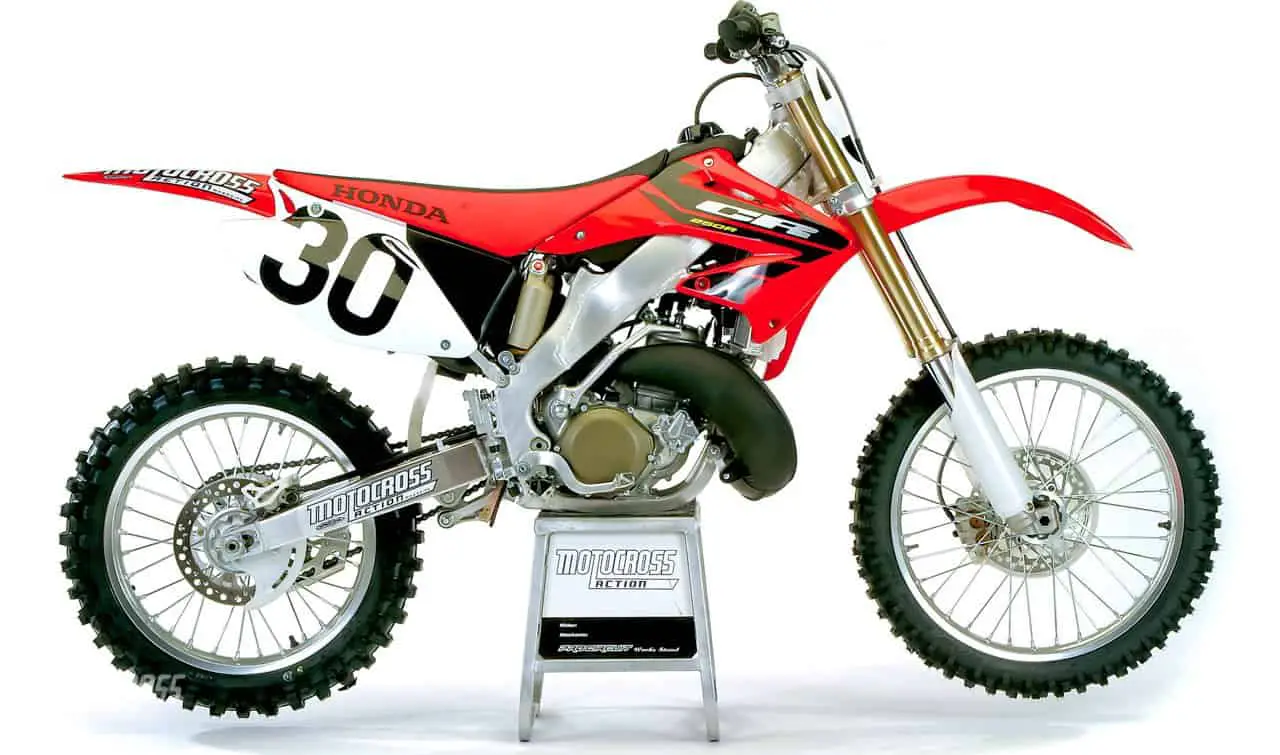 This test was pulled from the archives out of the January 2004 issue of MXA.
This test was pulled from the archives out of the January 2004 issue of MXA.
Honda has traversed a rocky road with the aluminum-framed CR250. When it was first introduced in 1997, the aluminum-framed CR250 displayed serious push in the front end and an overdose of rigidity. In 2000, the second-generation frame managed to curtail some of the push and lessen the alloy ping. Yet consistent criticism sent Honda back to the drawing boards in 2002 for the third aluminum frame. Less push, more resilience and better ergos allowed the aluminum frame to live up to its potential. But, by then, the critics had turned their attention to the CR250’s case-reed engine, unveiled in the 2002 model. Whatever positives that the generation-3 frame earned, the sluggish low-end of the case-reed engine overshadowed them.
Now, in its third year with this frame and engine, Honda has decided to focus on the CR250’s lack of punch. Did they succeed?
Q: WHAT DID HONDA DO TO THE 2004 CR250 ENGINE?
A: In our opinion, Honda’s take on case-reed theory has always been stifled by a too-generous crankcase volume. So, for 2004, Honda went to work on the complete intake tract with a five-point plan.
(1) Air boot: Starting behind the carburetor, Honda increased air boot volume by 6.5 percent.
(2) Carburetor: Honda’s 38mm Mikuni TMX carburetor got a reconfigured throttle position sensor (TPS) to improve throttle response.
(3) Reed cage: For the umpteenth time, Honda’s engineers came up with a different reed valve layout.
(4) Cases: The shapes, angles and volumes of the engine cases’ intake tract were modified to improve mixture flow.
(5) Porting: The exhaust port shape and height were changed.
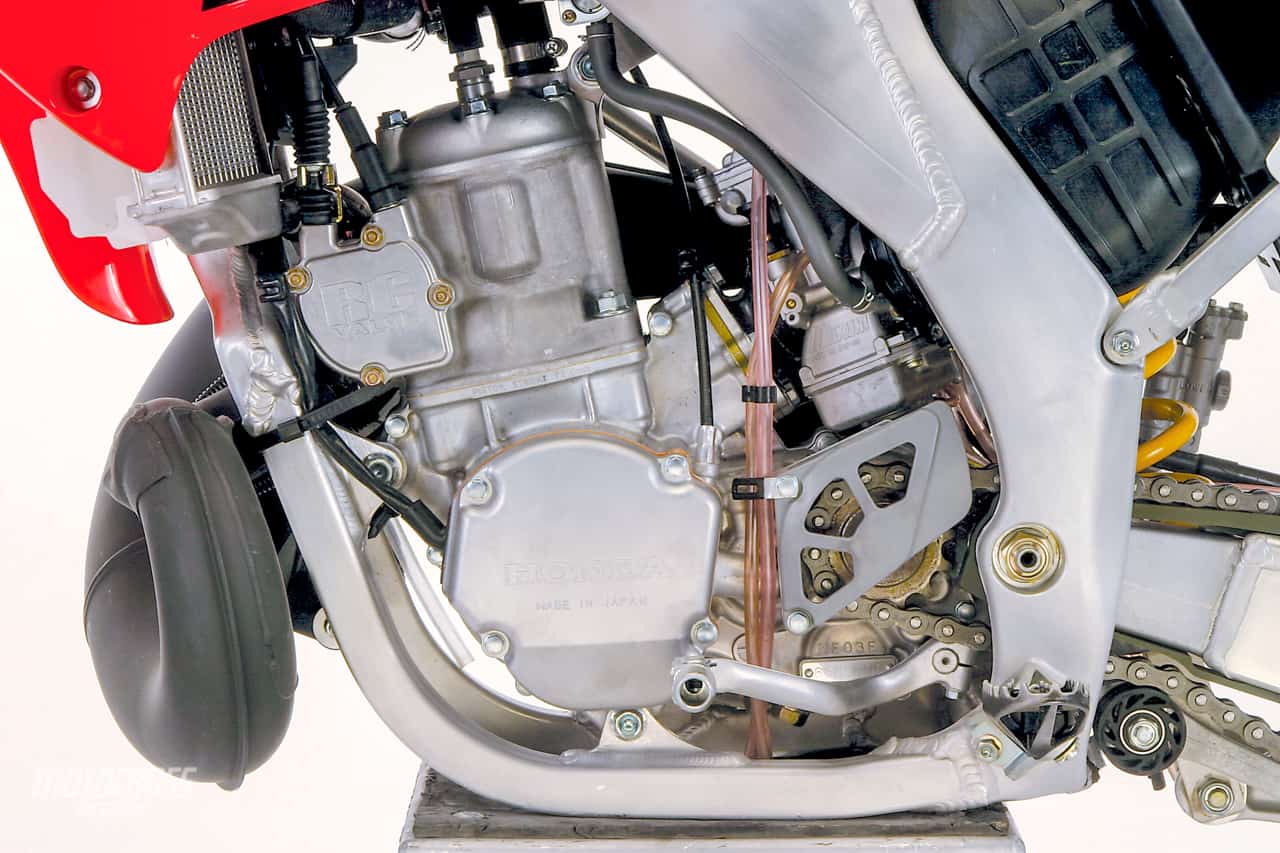 The 2004 CR250 powerplant had a low-to-mid transition that was strange…not strange good, but strange bad.
The 2004 CR250 powerplant had a low-to-mid transition that was strange…not strange good, but strange bad.
Q: DO THE CHANGES MAKE THE 2004 CR250 BARK?
A: No. Honda’s case reed engine suffers from a serious case of the blahs. Oh ,don’t get us wrong, the 2004 CR250 makes acceptable horsepower and can turn competitive laps, it’s just that you are working harder than YZ, RM or KTM riders. The low-to-mid transition is strange…not strange good, but strange bad. More than any 250 we’ve ever raced, the CR250 is “clutch-activated.” In stock trim, the CR250 powerband has a muffled sensation that is very uninspiring. But, when you touch the clutch, the engine comes to life. Pulling the trigger on the clutch lever gooses the CR250’s output. MXA test riders clutched it out of every corner.
Q: WHAT IS THE STRANGE PART OF THE CR250 POWERBAND?
A: There are moments, especially on the exit of corners that lead to doubles or step-ups, where the CR250 engine gets lost in an electronic no-man’s-land. In our opinion, there are certain rpm ranges where the CR250’s multi-map ignition seems to get stuck between ignition curves. The engine hangs, refuses to rev, almost refuses to run, and, to make matters worse, if something doesn’t happen, you won’t clear the double. It’s strange in a scary way.
Every CR250 rider has spent a few desperate moments in this electronic vortex. Clutching it jumps the CR’s ignition up to the next map. You will clear the double if you clutch it fast enough.
Q: IS THE 2004 CR250 ENGINE FASTER THAN THE ’03?
A: No. All the changes resulted in no change.
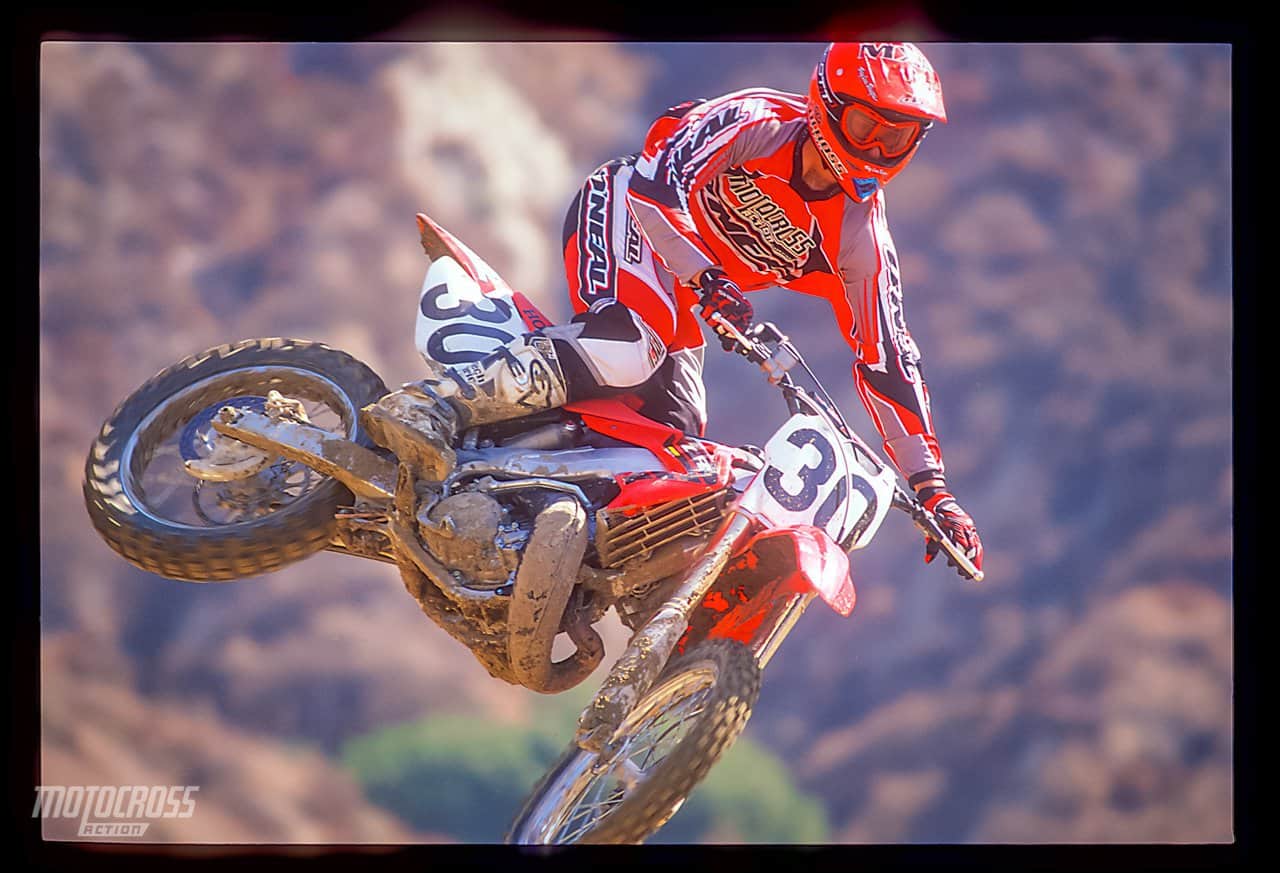 The third generation CR250 aluminum frame was a step up in resilience, fit and feel. The new chassis was lighter, flexier (in the right direction) and stiffer where it needed to be.
The third generation CR250 aluminum frame was a step up in resilience, fit and feel. The new chassis was lighter, flexier (in the right direction) and stiffer where it needed to be.
Q: WHAT ABOUT THE CR250 GEARING?
A: Given the CR250’s rather broad, but flat, powerband, we thought it would be best to gear the CR250 down. It wasn’t such a good idea, except on tight tracks. Since you are going to be using the clutch all the time — stick with the stock gearing.
Q: WHAT ABOUT THE SHOWA SUSPENSION?
A: When Honda unveiled its Generation-3 aluminum frame in 2002, it was enhanced by significantly improved suspension settings. Although the Showa stuff tended to ride down in the stroke, it didn’t suffer from the dreaded midstroke harshness that had plagued CR’s since 1987. The 2004 settings aren’t all that different from last year’s setup (with the exception of better honing on the tubes). As a rule, the complete suspension set-up works best at medium speeds — if you go fast, you’ll want to go stiffer.
Forks: These are fairly decent forks, and Honda was smart not to fiddle too much (since their track record with suspension changes has been spotty at best). The forks have a nice feel, but ride a little low in the stroke. The stock fork springs are 0.44 kg/mm (fast riders should go to stiffer 0.45s).
Shock: There is an old adage that “when the front forks work, the rear shock works.” For years, the Showa front end has put the onus on the CR250’s rear shock. The shock got a bad rap, even though it has always been workmanlike. Finally, the addition of better front forks has allowed the rear suspension to show its potential.
The stock shock spring is a 5.1 kg/mm. We ran the high-speed compression at 1-3/4 turn out, low-speed on 10 out and the rebound on 7 clicks out.
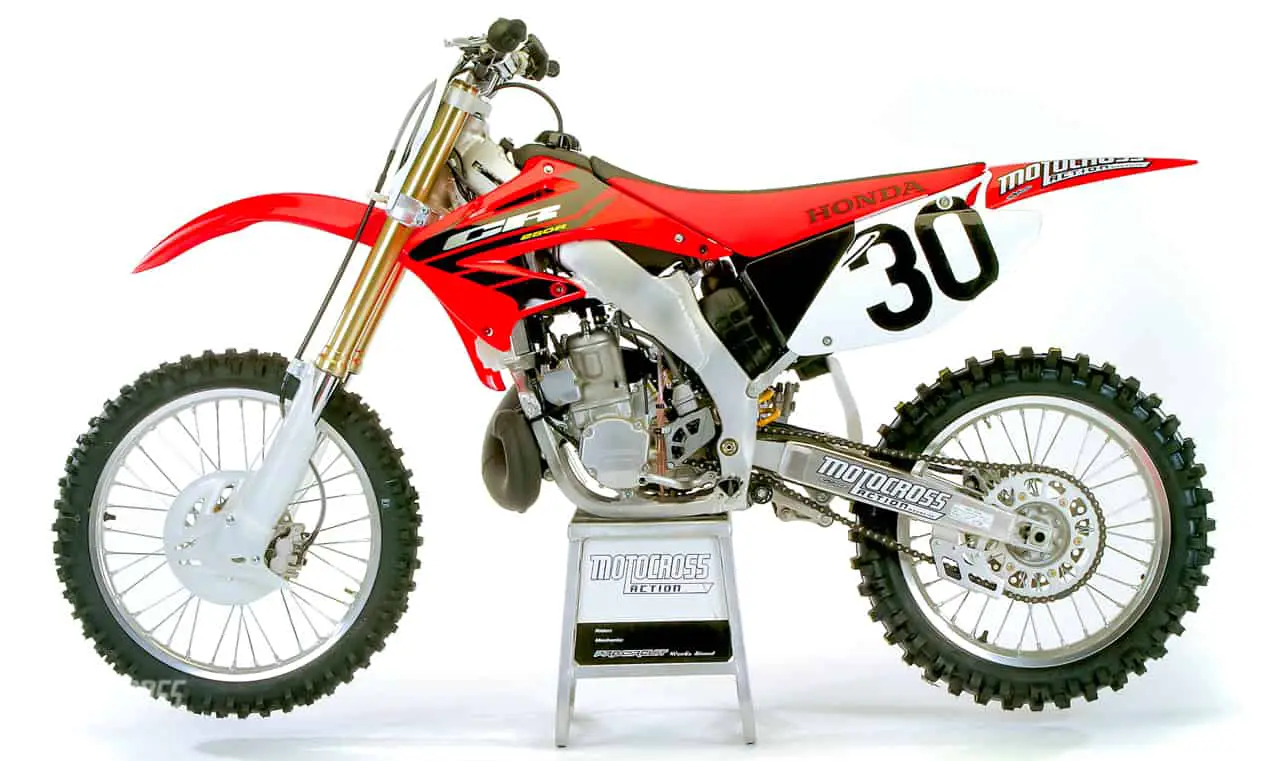 The Showa forks have a nice feel, but ride low in the stroke. The stock fork springs are 0.44 kg/mm (fast riders should go to stiffer 0.45s).
The Showa forks have a nice feel, but ride low in the stroke. The stock fork springs are 0.44 kg/mm (fast riders should go to stiffer 0.45s).
Q: HOW DOES IT HANDLE?
A: To understand Honda handling, you need to go back a decade to see how Honda got to where it is today.
1993: Old school CR riders loved the 1993 frame. It was quick, agile and accurate. This was Jeremy McGrath‘s favorite frame (he used it during his whole Team Honda career). Honda’s engineers, however, felt that the ‘93 frame had too much head shake.
1994-1996: From 1994 through ’96, Honda’s efforts to cut down on head shake created handling that was a compromise at best. Although the CR’s didn’t shake as much, they didn’t turn very well either.
1997-1999: The first aluminum frame was less than successful. The front end had a big push that made flat and off-camber corners a nightmare. And the rigid frame transmitted every jolt to the rider.
2000-2001: After three years of lackluster cornering, Honda made geometry changes for 2000 (including a single down tube and revised head angles). The second generation changes brought the 2000 and 2001 frame back to its ‘94 to ‘96 standards.
2002-2004: The third-generation aluminum frame was a step up in resilience, fit and feel. The new chassis was lighter, flexier (in the right direction) and stiffer where it needed to be. Cornering is good, but not exceptional (although it is better than every CR frame before, but not including 1993).
Q: WHAT DID WE HATE?
A: The hate list:
(1) Rear brake: The CR’s minuscule brake pads tend to overheat. If you are a brake dragger, you will suffer chirp first and fade later.
(2) Air filter: Honda’s air filter is the exact same size as the airbox. That isn’t as good as it sounds.
(3) Powerband: This bike lives in the “blah zone.”
(4) Radiators: We can turn the rectangular radiators into trapezoids with our knees.
(5) Power valve: Watch the cable tension on the electric power valve like a hawk. If the cable goes slack, so does the power.
(6) Shifting: It’s got a sticky wicket.
Q: WHAT DID WE LIKE?
A: The like list:
(1) Handlebars: You can’t complain when a bike comes stock with Renthal 971s.
(2) Tires: We like the Dunlop D742/756 combo. It’s best suited to intermediate terrain, but then, so are we.
(3) Clutch perch: Honda has joined the on-the-fly club (only Kawasaki is a nonmember).
(4) Saddle: We liked the gripper material down the centerline.


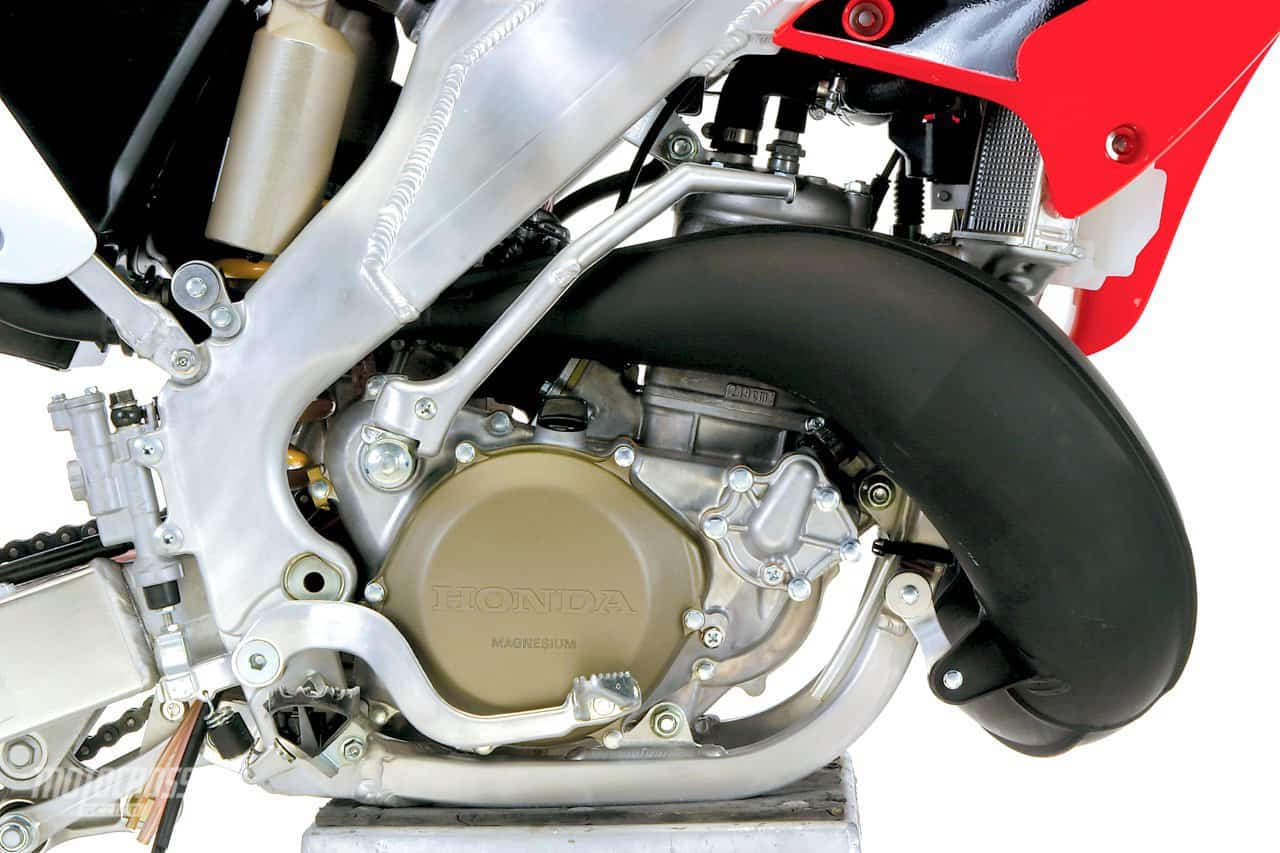



Comments are closed.